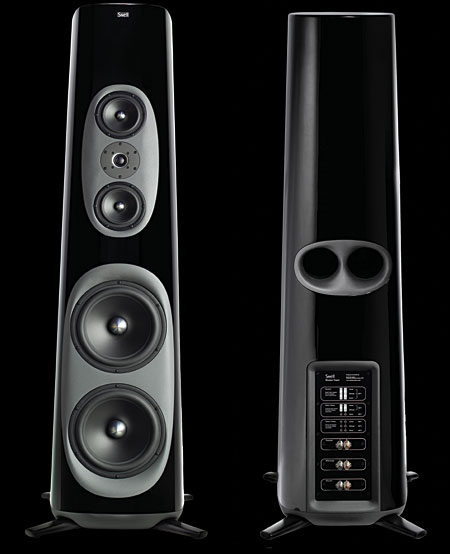| Columns Retired Columns & Blogs |
Snell Illusion loudspeaker
"How do you make an object common as a box iconic?" asked Bob Graffy, Snell's vice president/brand manager. He and Joseph D'Appolito, Snell's chief design engineer, were sitting in my listening room, discussing cabinet designs. Graffy noted that KEF had sought the same in their distinctive, silvery, cylindrical Muon loudspeaker ($150,000/pair). For the flagship model in their Illusion series, Snell commissioned Gerd Schmieta, former designer for Ideo, to integrate D'Appolito's wish list for an ideal enclosure: a narrow, rounded upper baffle for the midrange and tweeter, wider at the base for the woofers, holding a constant cross-sectional area while maximizing cabinet volume, and compliance with a 15° tip test.
Footnote 1: Peter Aczel, The Audio Critic, Vol.1 No.4 (1977), pp.38–39.

A Remarkable Shape
In the 30 years before the Illusion became a gleam in D'Appolito's eye, Snell Acoustics had already designed and manufactured six full-range, floorstanding Type A models. The first Type A was an "upright brick of polished wood and stretched cloth" (footnote 1) that functioned best when standing against a wall. The last Type A, the Reference, was designed by Kevin Voecks, who is now with Revel. Its 600 lbs of wood and steel included two 6'-tall midrange-tweeter Towers, two 5'-tall SUB 1800 bass enclosures, massive looms of Kimber Kable, and an external crossover. In his "Measurements" section accompanying my review in the March 1996 Stereophile (Vol.19 No.3), John Atkinson said that the Type A Reference possessed an ultraflat frequency response and a superb coupling of low frequencies with room acoustics.
The new Illusion ($50,000/pair) is 6" shorter, 6" wider, 9" deeper, and 25 lbs heavier than its predecessor. It has two 10" woofers per enclosure, not the single 18" woofer per channel used in the Type A Reference's SUB 1800, a lower voltage sensitivity (89dB vs 92dB(B)/2.83V/m), and a much higher maximum amplifier power rating into 4 ohms (1000 vs 600W). And, of course, it's a three-way system rather than a 4.5-way system.
Gerd Schmieta's enclosure looks nothing like the slim tower of the Type A Reference. No surface is parallel to any other; the Illusion is a gracefully tapering column whose top and bottom surfaces are ellipsoids of equal area but different shapes. The column maintains a consistent cross-sectional area, with greater width at the bottom for the two 10" woofers, but a narrower top to limit high-frequency corner diffraction of the tweeter's output. Sonic reradiation is further curtailed by the smoothly elliptical radius of the speaker's front baffle. Like those of the buildings designed by Frank Geary—such as the "Fred and Ginger" office structure in Prague—the asymmetrical profile of the Illusion presents a changing profile from every viewed angle.
The Illusion's enclosure of costly, four-layer, sandable MDF (standard MDF tears or pills when sanded) is milled by a CNC router. The cabinet's exterior is finished using an automotive process of multiple coats of primer and paint followed by hours of polishing with a buffing wheel. Each Illusion is shipped in a thick wooden crate that weighs 75 lbs when empty.

The Illusion flagship was designed by Joseph D'Appolito, whose vertical driver array of midrange-tweeter-midrange bears his name and is used by many other loudspeaker manufacturers. Properly implemented, a D'Appolito array can produce a horizontal radiation pattern of widely dispersed sound while minimizing the music-blurring first reflections of soundwaves off the floor and ceiling. D'Appolito computer-modeled the Illusion's exact driver configuration using the drive-units' dimensions and parameters, the crossover's time-domain characteristics, and the cabinet's interior volume. The resulting vertical array places the tweeter 42.5" above the floor and is designed to deliver a 15°-wide vertical dispersion pattern with 30° nulls, in order to reduce floor and ceiling reflections and thus maintain the speaker's transparency while promoting good soundstage imaging and depth.
The Illusion's drivers and rear ports are held in rigid alignment by massive, precisely machined bezels of cast aluminum alloy. Further rigidity is achieved by machine-screwing the drivers to the bezels, not into the cabinet's MDF. All drivers are wired in positive polarity.
The soft-dome tweeter—a 29mm, top-of-the-line SEAS Crescendo—boasts resonance-free output up to 40kHz, and very-low–distortion performance well down into the midrange for proper blending of amplitude and directional responses of the D'Appolito array. The tweeter's low 600Hz resonance gave D'Appolito confidence that it could be smoothly crossed over to the midrange driver at 2.5kHz. This tweeter employs SEAS's highly efficient Hexadym magnet structure (patent pending), a ring of six small, radially magnetized neodymium magnets in a focused hexagonal array. The motor's open-backed structure is said to eliminate backwave reflections, and the silk dome is free from the single breakup mode that is characteristic of metal-dome tweeters.
D'Appolito requested that SEAS fine-tune its top-of-the- line 5.25" midrange driver to expand its frequency response to five octaves. This cast-magnesium cone of this driver (two are used in the Illusion) has optimal stiffness and minimal mass; its natural-rubber surround is said to eliminate edge resonances, and its open basket of injection-molded aluminum alloy permits the free movement of air behind the cone, to reduce cavity resonances and turbulence noise in this driver's transmission-line subenclosure. A scaled-up Hexadym magnet similar to the one used in the tweeter includes heavy copper components that surround the pole-piece to optimize dynamic linearity and power handling.
Footnote 1: Peter Aczel, The Audio Critic, Vol.1 No.4 (1977), pp.38–39.
- Log in or register to post comments




































